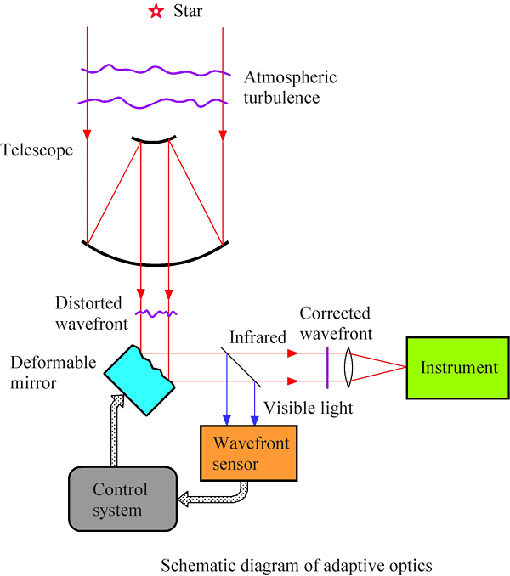About the Subaru Telescope
Observational instruments
AO System (Subaru Adaptive Optic System)

The Sharpest Sight from Earth
Due to turbulence in the Earth’s atmosphere, optical-infrared ground-based telescope always have lower resolution compared to space-based telescopes of the same size. The adaptive optics system removes this limitation by compensating for turbulence in the Earth’s atmosphere in the real time. The AO system itself doesn’t have a detector; it is used in conjunction with a separate near-infrared instrument such as IRCS or CIAO.
▶︎Topics
Scientific Results (December 2000) Adaptive Optics First Light !

AO mechanism
Light from a star travels through empty space as a smooth wave front which is then disturbed by the Earth’s atmosphere. Consequently, an image of a star taken from a ground-based telescope is blurred compared to an image taken from space. An adaptive optics (AO) system installed between the telescope and observing instrument can compensate for the blurring due to atmospheric turbulence and recover a sharp image. The increased resolution provided by AO helps in the detection of detailed structures but also in the detection of dim objects by concentrating light into a smaller and higher intensity peak.
Subaru’s AO system uses a wave front curvature sensor to measure wave front disturbance and a deformable mirror with 36 actuators to correct the disturbance. Under good observing conditions, the AO system can deliver diffraction-limited images (i.e. without any blurring) at a wavelength of 2.2microns.

Binary brown dwarf
The pictures above show a star named HD 130948 taken with a combination of AO and IRCS. HD 130948 is a 6th magnitude normal star in the constellation Bootes and is located 60 light years away from us. In the top left panel, you may see two faint dots to the left of the bright primary. Their presence is difficult to recognize in the image taken without AO (top right panel). Spectroscopic observation with AO ( bottom right panel) revealed that the binary companions are a brown dwarf pair. A brown dwarf is a very light star weighing as little as just one hundredth of the mass of the Sun. Since it cannot continue to shine like normal stars by nuclear fusion of hydrogen atoms, it is often called "a failed star". The separation between the two companions is as small as 0.13 arcseconds, which is comparable to seeing the Eiffel tower from the Moon.
► First Spectroscopic Observations with Subaru's Adaptive Optics (Jan. 16, 2002)

Interview
The Earth’s atmosphere limits what we can observe from the ground even with a large telescope. Light from a point-like source always appears extended due to scattering by the atmosphere. Adaptive optics is a way to overcome the limitations imposed by the Earth’s atmosphere and to take full advantage of a large telescope.
Atmospheric conditions change rapidly, and tuning the AO system to perform at its peak as conditions change is challenging. The brightness of a star remains the same, but the size of a star, called seeing, can quickly change. If the natural seeing is smaller than 0.5 arcseconds, the AO system can correct for the atmosphere and we can achieve the theoretical limit of the telescope.
Using AO, we can separate objects that are very close together and observe them individually. By better concentrating light, we can get spectra from objects that might otherwise be bright enough for imaging, but too faint spectroscopy. The AO system is used in conjunction with as infrared observing instrument like CIAO or IRCS.
(Form an interview with Shin Oya, support scientist for Subaru’s adaptive optics system.)
Upgrade:
We plan to upgrade the current AO system as we continue to observe with it. The two major upgrades are: increasing the number of actuators for the deformable mirror and introducing a laser guide star system. By increasing the number of actuators, we can correct smaller distortions in the wave front. The new AO system will be more effective under bad seeing conditions and at shorter wavelengths. A laser guide star system will increase the number of observable objects. The AO system requires a bright guide star near the target object for measuring disturbances in the wave front. A laser guide star system makes an artificial guide star when a natural guide star is missing by generating a light spot on the sodium layer of the Earth’s atmosphere at an altitude of 90 kilometers. Using a laser star system, the bulk of the sky accessible from Mauna Kea becomes observable with AO.
